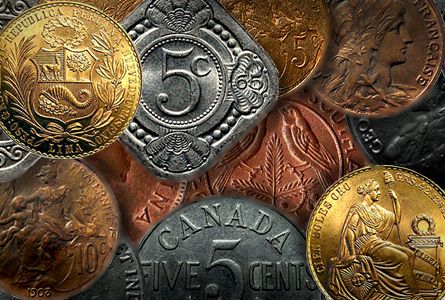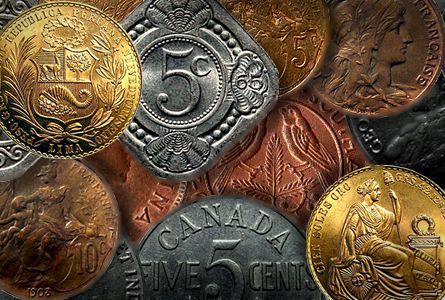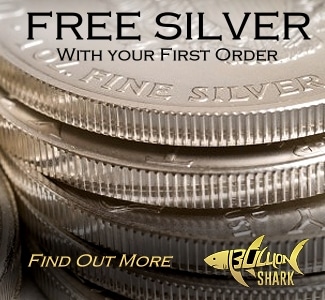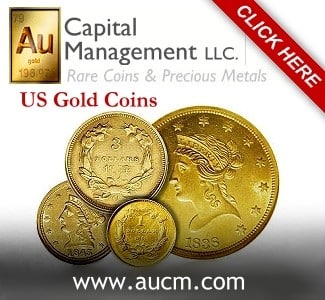One-year world type coins of the 1800s
By Al Doyle for CoinWeek….
American coin collectors are naturally attracted to one-year type coins. This category includes the incredibly affordable 1883 Liberty no-cents nickel, the very rare (mintage 6146) and costly 1796 Draped Bust small eagle reverse quarter and a smattering of other issues.
Likewise, the world coin field offers an assortment of one-year wonders. Why do nations go to all the trouble of creating and producing new designs only to discontinue them within months? Revolutions and economic hardship are the main causes, but a small nation may not need another run of coinage for years or even decades if a large quantity was initially struck.
 Collectors who gravitate to this segment of numismatics can vastly expand their options by pursuing the one-year type coins that were made beyond the United States. Here are some of the short-lived silver and base-metal pieces of the 1800s and 1900s.
Collectors who gravitate to this segment of numismatics can vastly expand their options by pursuing the one-year type coins that were made beyond the United States. Here are some of the short-lived silver and base-metal pieces of the 1800s and 1900s.
Bolivia’s 2 centavo of 1883 (mintage 250,000) bears more than a casual resemblance the the Argentine 2 centavo of the 1880s and 1890s – and that’s not a bad thing, as it’s an attractive design. This copper is also reasonably priced, often for less than $20 depending on grade.
Canadian collectors are aware of the 1858 20-cent piece, which came with a large (for that time) mintage of 730,392. More than 150 years after debuting, this .925 fine/sterling silver issue remains the only circulating coin of this denomination by Canada. The “double dime” was replaced by the quarter in 1870.
France’s contribution to the one-year coin list is the 1852A 50 centimes. Just over 1 million pieces featuring the bust of Napoleon III were struck, and they saw extensive usage in commerce. That means anything in Extra Fine or better is going to be somewhat more costly than lower-grade survivors.
How about some affordable silver? The Guatemalan 1 real of 1899 had an alloy of .600 fine silver, and that lower than normal precious metal content is noted on the coin. The quetzal with its flowing tail is the national symbol, and the jungle bird can be found on the reverse. Circulated examples go for less than $10.
American numismatists who look at the 1889 Haitian 5 centimes for the first time may feel a sense of deja vu. That’s because the rays surrounding the number 5 on the obverse serve as a reminder of the 1866-67 Shield nickel with rays. Haiti’s coat of arms covers the reverse. The original mintage was 120,000, and this one-hit wonder sells for $25 to $200 in circulated grades.
Want tiny and rare in the same package? Check out the 1848 Netherlands 5-cent silver, which contains just .0141 ounce of the precious metal in a .640 fine alloy. It would take 70 of these dinky coins to nearly reach an ounce of silver. The mintage is unlisted, and circulated examples sell in the low four figures.
Scarcity isn’t a challenge with Japan’s 1871-dated silver 50 sen, as nearly 2.65 million were struck. Unlike later sen pieces, all of the legends are in Japanese. The traditional dragon obverse is paired with a rising sun reverse.
The Prince Edward Island penny is another 1871 product. Why weren’t more coppers struck after the sole year of production?
A mintage of 2 million for an area with a population of just 95,000 guaranteed that a second batch wouldn’t be needed for years to come. Prince Edward Island was a British colony at the time the coins were struck, and the Delaware-sized island became the seventh member of the Canadian confederation in 1873. That meant the adoption of the Canadian dollar and the end of the need for distinctly “PEI” coinage.
This is both an attractive and affordable (as in $5 to $20) piece of history. The obverse features an uncrowned portrait of Queen Victoria flanked by the legend “VICTORIA QUEEN” and the date at 6:00. The reverse carries the island’s logo of a pair of trees.
How about multiple one-year coins from the same nation? Paraguay released 1, 2 and 4 centesimos coppers in 1870 just after the conclusion of the utterly ruinous War of the Triple Alliance. All three pieces are reasonably priced in circulated condition. As an odd denomination, the 4 centesimos also appeals to collectors who like the offbeat.
Puerto Rico’s 5, 10, 20 and 40 centavos along with a crown-sized peso were all one-shot deals. The 20 centavos and peso carry an 1895 date, while the 5, 10 and 40 centavos were struck in 1896. This is the only decimal coinage made for Puerto Rico under Spanish rule. The island became a U.S. commonwealth following the Spanish-American War of 1898. Plan on spending serious money for the 40 centavo and peso. All of the Puerto Rican issues are .900 fine silver.
Even the most stable nations can have a one-year design, and Australia took the hat trick with the 1910-dated three pence, six pence and shilling. Those sterling silver (.925 fine) issues carry the portrait of King Edward VII, who passed away on May 6, 1910.
 Austria‘s 1934 50 groschen gave way to a different design the following year. This artistically pleasing copper-nickel coin starts at $20 in the “collector grades” of Fine and better.
Austria‘s 1934 50 groschen gave way to a different design the following year. This artistically pleasing copper-nickel coin starts at $20 in the “collector grades” of Fine and better.
The 1943 Belgian Congo 2 franc passes the “Wow, that’s cool!” test. Combine an elephant with a six-sided (or hexagonal) planchet with an odd denomination, and brass coinage never looked so good. Lightly circulated examples shouldn’t cost more than $20.
Aside from being one-year type coins, what’s noteworthy about the 1910 Bulgarian 50 stotniki, 1 lev and 2 leva? They are the same size and fineness (.835 silver) as the Swiss 1/2, 1 and 2 franc pieces.
World War II led to much improvisation in coin production, and the Canadian 5-cent piece of 1942 was made from a “tombac” brass alloy instead of pure nickel. Fewer than 3.4 million of these 12-sided pieces were struck before the familiar beaver reverse was replaced with a V for victory from 1943 to 1945.
The free city of Danzig (now Gdansk, Poland) was an independent entity from 1919 to 1939. Among the coins issued during this time were the .750 fine 1923 silver gulden and the 1932-dated pure nickel 1/2 gulden complete with the fractional denomination on the reverse.
Deuces were wild in Ecuador from 1909 to 1928. Check out the 1909 copper-nickel 2 centavo, the 2 1/2 centavo of 1917 and the redesigned 1928-dated pure nickel 2 1/2 centavo. The 1917 is the scarcest and most costly of the trio.
Check out Greece‘s 1912 10 lepta for something novel. This pure nickel coin with a hole in the center features a nicely detailed owl on the reverse, and it’s a low-cost item in circulated grades. The denomination was revived briefly in the 1940s, but the 1932 Guatemala 2 centavo is a one-year wonder with an eye-catching appearance.
What would 1/24 of a shilling buy in 1909? That’s the very unusual denomination of a copper piece that circulated on the British crown dependency of Jersey. The 45-mile square island is closer to France than Britain. The mintage is 120,000.
Ships and boats are a popular theme for topical collectors, and Lebanon‘s 1961 10 piastres combines an old-fashioned sailing vessel with a Lebanese cedar tree. It’s very affordable in all grades.
Copper enthusiasts can choose from a vast assortment of designs, and the 1906H Liberian cent is an interesting object. The 10-cent and 25-cent pieces of that year are just a little smaller than their American counterparts.
Lithuania was an independent nation from 1918 until the Soviet occupation of 1940. The .500 fine silver 1 litas of 1925 is a nice example of Lithuanian artistry. The 1936 bronze 2 centai has more flair than the average low-denomination coin.
A square planchet makes the 1940 Malaya 1/2 cent appealing to collectors who like something unusual. What’s missing from the 1935 Mexican 50 centavo which looks like the rest of the coins of that denomination struck from 1919 to 1945? Every other date carries the .720 silver fineness on the obverse, while the 1935 was made with a .420 fine planchet.
The first postwar Netherlands 25-cent piece was struck in 1948 with Queen Wilhelmina I on the obverse. The mintage of 32 million means this pure nickel coin isn’t scarce.
Panama has several one-year wonders. The 1907 1/2 centesimo was struck in a copper-nickel alloy, while the 1 1/4 centesimos of 1940 is one of the more eccentric 20th century denominations. Then there’s the famed “Panama pill”, a dinky 1904-dated 2 1/2-centesimo piece with a .900 fine silver planchet.
A lion is paired with a Phrygian cap on the 1903-dated 5, 10 and 20 centavos from Paraguay. The copper-nickel pieces are reasonably priced in circulated grades but are more elusive in Mint State condition.
Older and modern Polish coins display considerable artistic talent. Check out the elaborate engraving on the 1923 10 and 20 groszy along with the larger 1929 1 zloty. All three made in Warsaw pieces are pure nickel.
Inscriptions in French and Arabic along with a center hole makes the 1920 Tunisian 5 centimes anything but a generic item. Plan on spending at least $30 to obtain this one in Extra Fine.
The national coat of arms and a crowned hornbill bird can be seen on Zambia‘s 1964 shilling, while a reedbuck (African antelope) appears on the 2 shillings of that year. The pair can be obtained for $10 or less in uncirculated condition.
Why assemble long date sets of essentially identical pieces from the same series when one-year type coins offer such variety?
If variety, art and an appreciation of history are among your priorities, one-year world type coins are a field worth exploring – and the cost of the journey can be very reasonable.




